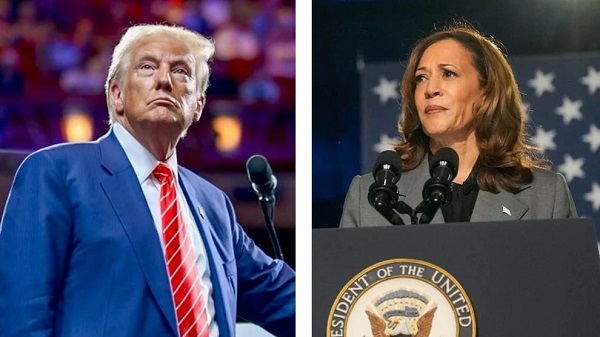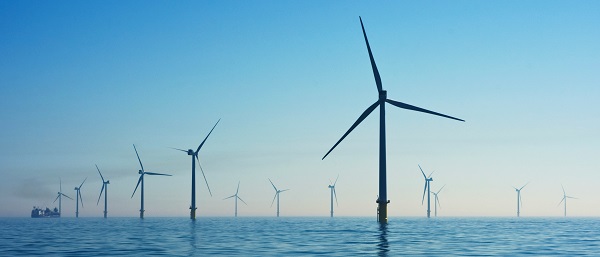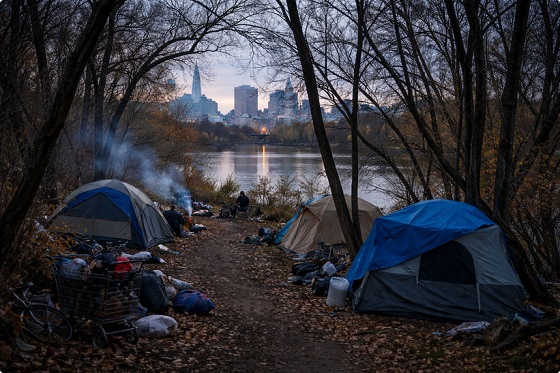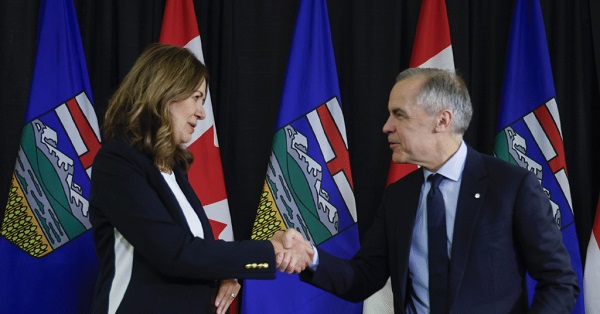Opinion
The majority of voters have moved on from legacy media and legacy narratives

From EnergyNow.ca
By Margareta Dovgal
A Wake-Up Call for Political Strategists Across the Continent
For only the second time in US history, a president has lost, left office, and won re-election. For most Canadians watching the US election, the news of Donald Trump’s impending return to the White House comes with some degree of disappointment – and confusion.
Rather than getting caught up in doomsaying as there’s enough of that going around, I wanted to share some thoughts on what I would hope Canadians working in and around politics and policy come away with.
Speaking to the heart shouldn’t neglect speaking to the wallet
Biden probably should have resigned sooner, and Harris should have gone through a competitive primary race before carrying the flag. Hindsight is 20/20, and I doubt that the Democrats will make those same mistakes twice.
What I do suspect will be harder to shake is the commitment to running campaigns on social issues alone. The Democrats made the gamble that reproductive rights were a persuasive enough ballot box question to distract from Joe Biden’s lacklustre economic performance.
The clear majority of voters showed that they are more concerned with their job security, housing affordability, and tax bills.
The Democrats now have an opportunity to realign with the concerns of working Americans, recognizing that economic anxieties cannot be overlooked. A robust economic approach doesn’t preclude a moderate and fair social approach, but the latter can’t replace the former.
In Canada, this holds true for our discussions around energy and resources. I’m seeing a very similar disconnect play out on resource policy. Patently bad policies with horrible economic impacts are being advanced at all levels by governments more concerned with virtue signalling than ensuring robust economic performance – the federal Emissions Cap and the fantastical ambitions of David Eby’s CleanBC program among them.
Pre-pandemic, vibes-based economic policy seemed to work. In times of plenty, it is easy to persuade voters that taking economic hits is the right thing to do — after all, why worry about the price of something if you can afford it? Anyone still trying that in 2024 has lost the plot.
Affordability remains a paramount issue for many citizens, and the U.S. election highlighted how campaigns that overlook economic concerns and the declining quality of life risk alienating voters.
From groceries to gas prices, the rising cost of living is top of mind for Canadians, and resource policies must reflect this reality. For instance, a balanced approach to energy production can help keep costs reasonable while supporting Canadian jobs and industries.
It’s a reminder that beyond political credibility or mainstream appeal, policies that directly address financial challenges resonate most with the electorate.
For the resource sector, this means recognizing how affordable energy, resilient supply chains, and robust employment opportunities are interconnected with national policy priorities.
Truth and gatekeeping
The gamesmanship over who holds the authority to define “truth” continues in earnest, and engaging in it by discounting mass popular narratives is a risky gambit for any political movement that seeks to maintain widespread relevance.
We’re seeing a generational change, not just in the US but globally, on how people consume and produce media.
I would argue that Elon Musk’s purchase of Twitter was the edge that Trump needed in this new era. Millions of Americans, and millions abroad, sought news and commentary from the platform. Political discourse on the 2024 election was shaped by the ideas generated and amplified online, faster than mainstream news could reliably pick up on.
Since Musk’s acquisition of Twitter/X, the editorial stance, algorithm, and tone of the platform have all shifted. Yes, it has gone ‘rightwards’, but rather than that serving to shrink the audience, it has instead grown, picking up swing voters and rallying the “persuadeds” more effectively.
Just look at the last debate between Trump and Harris: they weren’t even talking about the same political realities.
Research finds that as a main source of news, social media is still behind TV. Where we see the biggest difference is among younger voters.
46% of Americans 18-29 say social media is their top source of news, according to Pew Research. Beyond widespread appeal or readership, social media drives the political commentary of the chattering classes more than any one other platform. TikTok’s influence is likewise growing, with an even younger demographic relying on it almost entirely to help shape and articulate their views.
A similar dynamic around “truth” was plainly obvious in British Columbia’s provincial election last month. A good chunk of commentators couldn’t fathom that voters could accept a party that had refused to throw out candidates saying offensive or dubious things.
The BC Conservatives went from zero seats to just shy of government.
Enough ink has been spilled on this by other commentators, but let’s recap what many have said about the explanatory factors: BC United collapsed following its disastrous rebrand, the BC NDP was stuck with having to account with the inevitable baggage of incumbency in a struggling global economy, and the rise of Poilievre and the federal Conservatives lent some additional name-brand recognition to the BCCP.
The most important piece, in my estimation, was the Conservatives’ ability to tap into a growing demographic that didn’t feel their concerns were reflected in the mainstream political discourse. Twitter was far from the only forum for this, but I think it had a large part to play in cultivating the sense among many voters that consequential narratives were not even remotely being touched on in mainstream media. It gutted voters’ trust in the media, giving the BC Conservatives whose narratives were more effective on social media a decisive advantage.
Public safety is a great example of this. Anyone with eyes and ears who has spent time in Downtown Vancouver in recent years can attest to the visible decline, with visible drug use in public spaces, frequent run-ins with people with severe untreated mental illness yelling at phantoms, and unabashed property crime.
Yet, if we were to believe a great deal of commentators just up until the eve of the election, everything was just fine.
Willful blindness only works when people can’t comment on what they see. But comment they did, and the delayed response to it nearly cost the BC NDP the election.
In a purely practical sense, the increasing role of community-driven sources of information mean that gatekeepers can no longer control the flow of information. And let’s not mince words here: anyone concerned about misinformation is talking about gatekeeping.
Subjecting ideas out there in the commons to scrutiny is necessary. We just can’t take for granted that the outlets themselves will provide that editorial scrutiny directly, if it’s not baked in the platform by design and people are actively choosing to spend time on platforms that have a radical free speech mandate.
It’s time to accept that the train has left the station: persuasiveness needs to be redefined by the mainstream, rather than taking one loss after another and crying foul because the game has changed.
Canadian narratives for Canadian politics
Our closest neighbour and trading partner is the world’s largest economy, and Canadians can’t help but look south for news and ideas. Our own politics often mirror the messages we see in the US, and there’s no use trying to pretend that won’t keep happening.
If we want to avoid falling into the trap of inheriting the dysfunction and divisions that are increasingly defining the political system next door, we have a duty to develop compelling narratives that resonate with the unique needs of Canadians, across the political spectrum.
It’s the definition of insanity to keep trying the same things expecting a different result. Rather than directing anger at voters and political movements who have moved on from old media, if you’re not happy with the result, try meeting them where they are.
And no, this doesn’t mean ceding ground to conspiracy theorists or the fringe. They are only succeeding because a) they are speaking to issues that people decide they care about (like them or not) that are panned by the center and the left, and b) most crucially, there isn’t enough emotionally resonant, persuasive substance being put out to win hearts and minds.
These are not inevitable outcomes. Voter preferences and media technologies are constantly evolving. We need to evolve with them by subjecting our leaders to real scrutiny and demanding better.
Margareta Dovgal is Managing Director of Resource Works. Based in Vancouver, she holds a Master of Public Administration in Energy, Technology and Climate Policy from University College London. Beyond her regular advocacy on natural resources, environment, and economic policy, Margareta also leads our annual Indigenous Partnerships Success Showcase. She can be found on Twitter and LinkedIn.
Daily Caller
US Halts Construction of Five Offshore Wind Projects Due To National Security


From the Daily Caller News Foundation
Interior Secretary Doug Burgum leveled the Trump administration’s latest broadside at the struggling U.S. offshore wind industry on Monday, ordering an immediate suspension of activities at the five big wind projects currently in development.
“Today we’re sending notifications to the five large offshore wind projects that are under construction that their leases will be suspended due to national security concerns,” Burgum told Fox Business host Maria Bartiromo. “During this time of suspension, we’ll work with the companies to try to find a mitigation. But we completed the work that President Trump has asked us to do. The Department of War has come back conclusively that the issues related to these large offshore wind programs have created radar interference that creates a genuine risk for the U.S.”
Predictably, reaction to Burgum’s order was immediate, with opponents of offshore wind praising the move, and industry supporters slamming it. In Semafor’s energy-related newsletter on Tuesday, energy and climate editor Tim McDowell quotes an unnamed ex-Energy Department official as claiming, “the Pentagon and intelligence services, which are normally sensitive to even extremely low-probability risks, never flagged this as a concern previously.” (RELATED: Trump Admin Orders Offshore Wind Farm Pauses Over ‘National Security Risks’)
Yet, a simple 30-second Google search finds a wealth of articles going back to as early as October 2014 discussing ways to mitigate the long-ago identified issue of interference with air defense radars by these enormous windmills, some of which are taller than the Eiffel Tower. It is a simple fact that the issue was repeatedly raised during the Biden Administration’s mad rush to speed these giant windmill operations into the construction phase by cutting corners in the permitting process.
In May, 2024, the Bureau of Ocean Energy Management’s (BOEM) own analysis related to the Atlantic Shores South project contains a detailed discussion of the potential impacts and suggests multiple ways to mitigate for them. An Oct. 29, 2024 memo of understanding between BOEM and the Biden Department of Defense calls for increased collaboration between the two departments as a response to concerns from members of Congress and others related to these very long-known potential impacts.
The Georgia Tech Research Institute published a study dated June 6, 2022 detailing “Radar Impacts, Potential Mitigation, from Offshore Wind Turbines.” That study was in fact commissioned by the National Academies of Sciences, Engineering, and Medicine (NASEM), a private non-profit that functions as an advisory group to the federal government.
Oh.
A report published in February 2024 by International Defense Security & Technology, Inc. describes the known issues thusly:
“Wind turbines can create clutter on radar screens in a number of ways. First, the metal towers and blades of wind turbines can reflect radar signals. This can create false returns on radar screens, which can make it difficult to detect and track real targets.
“Second, the rotating blades of wind turbines can create a Doppler effect on radar signals. This can cause real targets to appear to be moving at different speeds than they actually are. This can also make it difficult to track real targets.”
The simple Google search I conducted returns hundreds of articles dating all the way back to 2006 related to this long-known yet unresolved issue that could present a very real threat to national security. The fact that the Biden administration, in its religious zeal to speed these enormous offshore industrial projects into the construction phase, chose to downplay and ignore this threat in no way obligates his successor in office to commit the same dereliction of duty.
Some wind proponents are cynically raising concerns that a future Democratic administration could use this example as justification for cancelling oil and gas projects. It’s as if they’ve all forgotten about the previous four years of the Autopen presidency, which featured Joe Biden’s Day 1 order cancelling the 80% completed Keystone XL pipeline, a year-long moratorium on LNG export permitting, an attempt to set aside more than 200 million acres of the U.S. offshore from future leasing, and too many other destructive moves to detail here.
Again, a simple web search reveals that experts all over the world believe this is a real problem. If so, it needs to be addressed as a matter of national security. Burgum is intent on doing that. All half-baked talking points aside, this really isn’t complicated.
David Blackmon is an energy writer and consultant based in Texas. He spent 40 years in the oil and gas business, where he specialized in public policy and communications.
International
No peace on earth for ISIS: Trump orders Christmas strikes after Christian massacres

President Trump said Christmas night that he ordered U.S. forces to carry out airstrikes in northwest Nigeria, targeting ISIS-linked militants he blamed for a campaign of mass killings against Christians.
In announcing the operation, Trump said the United States delivered “powerful and deadly” blows against terrorists who have been “viciously killing, primarily, innocent Christians,” adding that he had warned them repeatedly that the slaughter would bring consequences. He credited precise U.S. strikes, said his administration would not allow radical Islamic terrorism to take root, and closed with a Christmas message blessing the military while signaling more action if the attacks continue.
.@POTUS “Tonight, at my direction as Commander in Chief, the United States launched a powerful and deadly strike against ISIS Terrorist Scum in Northwest Nigeria, who have been targeting and viciously killing, primarily, innocent Christians, at levels not seen for many years, and… pic.twitter.com/ct7rUW128t
— Department of War 🇺🇸 (@DeptofWar) December 26, 2025
The strike followed weeks of intensifying reports documenting targeted violence against Christian communities across northern and central Nigeria, violence that multiple journalists and religious freedom advocates have described as genocidal in nature.
Islamist factions including Boko Haram and allied jihadist militias have, for more than a decade, carried out coordinated assaults aimed at erasing Christian villages from the Middle Belt and the north. Those attacks have repeatedly spiked around Christian holidays, particularly Christmas and Easter.
During a December 16 briefing attended by reporters and advocates, speakers described the violence as a deliberate campaign of obliteration. Steven Kefas of the Observatory for Religious Freedom in Africa pointed to the timing of the attacks as evidence they are religiously motivated, noting that assaults frequently occur on Sundays and Christmas Eve. If the killings were random criminality, he asked, why are Muslim communities not attacked on Fridays or on the eve of their own celebrations?
Critics say the crisis has been compounded by denials from Abuja. President Bola Tinubu has consistently downplayed the religious nature of the violence, framing it instead as banditry or climate-related conflict, and pushed back on international scrutiny even after Trump designated Nigeria a Country of Particular Concern for religious freedom earlier this fall.
While the Nigerian government later declared a state of emergency and dismissed senior defense officials, watchdog groups report that Christians who survive the attacks — and journalists who document them — continue to face threats and intimidation.
According to Open Doors, Nigerian Christians now endure an average of eight violent attacks every day, a level of brutality critics say the government has long minimized or ignored.
The issue has also drawn attention beyond Washington. In a Christmas Eve message, Benjamin Netanyahu said Israel remains the only Middle Eastern nation where the Christian community is thriving and added that militant displacement and attacks against Christians in Nigeria “must end.”
-

 Energy2 days ago
Energy2 days agoThe Top News Stories That Shaped Canadian Energy in 2025 and Will Continue to Shape Canadian Energy in 2026
-

 Frontier Centre for Public Policy22 hours ago
Frontier Centre for Public Policy22 hours agoTent Cities Were Rare Five Years Ago. Now They’re Everywhere
-

 International2 days ago
International2 days ago$2.6 million raised for man who wrestled shotgun from Bondi Beach terrorist
-

 Alberta2 days ago
Alberta2 days agoOttawa-Alberta agreement may produce oligopoly in the oilsands
-

 Fraser Institute7 hours ago
Fraser Institute7 hours agoCarney government sowing seeds for corruption in Ottawa
-

 International6 hours ago
International6 hours agoNo peace on earth for ISIS: Trump orders Christmas strikes after Christian massacres
-

 Opinion22 hours ago
Opinion22 hours agoPope Leo XIV’s Christmas night homily
-

 Daily Caller5 hours ago
Daily Caller5 hours agoUS Halts Construction of Five Offshore Wind Projects Due To National Security



